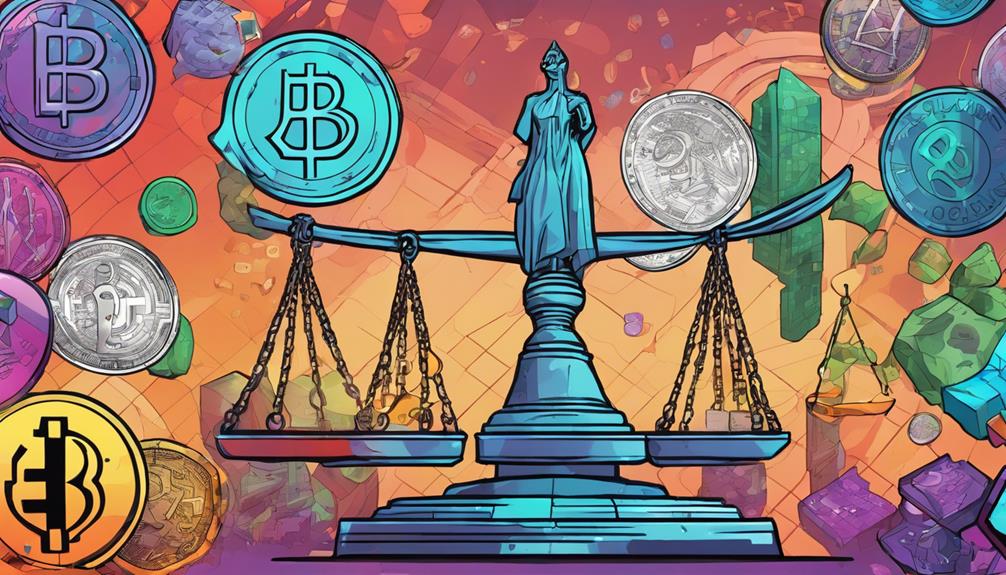
To make the most of your investments in the current altcoin market, you should combine both long-term and short-term strategies. Consider the HODL approach for potential appreciation while diversifying your portfolio to spread risk. For short-term gains, use techniques like scalping or day trading, and utilize technical analysis to identify trends. Monitor market sentiment and stay informed on news to anticipate price movements effectively. Implementing strict risk management measures like stop-loss orders is essential. Remember, the right mix of these strategies and insights can greatly enhance your trading results. There's plenty more to explore that can sharpen your approach.
Table of Contents
Long-Term Trading Strategies
When you adopt long-term trading strategies like HODL, you're aiming to benefit from the potential appreciation of altcoins over an extended period. This approach allows you to leverage favorable capital gains tax rates, which are generally lower than the steep short-term rates that can soar to 37%. While swing trading offers opportunities through price fluctuations, your focus on long-term holding can yield more substantial rewards as market trends evolve.
Diversification is key in your long-term strategy. By spreading investments across various altcoins, you can mitigate risks and enhance your portfolio's resilience. Experts suggest keeping crypto investments to about 5% of your total portfolio for balanced risk management.
Employing dollar-cost averaging aids in reducing the impact of market volatility. By investing fixed amounts regularly, you can lower your average cost basis and position yourself advantageously in both bullish and bearish conditions. Staying informed about market trends, regulatory shifts, and technological advancements is essential. This knowledge can guide your decisions and guarantee you're well-prepared for the future of your investments in the ever-changing crypto landscape.
Short-Term Trading Techniques
When it comes to short-term trading techniques, you've got several options to contemplate. From the rapid-fire execution of scalping to the strategic moves of day trading, each method can help you capitalize on market fluctuations. Understanding the basics of these strategies will empower you to choose the one that fits your trading style best.
Scalping Basics Explained
Scalping is a fast-paced trading strategy that lets you capitalize on small price movements in altcoins, often holding positions for just seconds to minutes. To succeed, you'll need to embrace rapid decision-making and leverage the right tools to act quickly on price fluctuations.
Here's a quick overview of key aspects of scalping:
| Aspect | Description | Importance |
|---|---|---|
| Profit Margins | Aim for 0.1% to 0.5% per trade | Builds wealth through volume |
| Risk Management | Use stop-loss orders to limit losses | Preserves capital in volatility |
| Market Conditions | Focus on highly liquid markets with high volume | Provides frequent opportunities |
Day Trading Strategies Overview
Day trading strategies allow you to buy and sell altcoins within the same day, taking advantage of short-term price movements to maximize your profits. By leveraging technical analysis, you can identify patterns and trends that inform your trading decisions. Here are some key elements to enhance your day trading approach:
- Scalping: Make numerous small trades to secure quick profits, requiring rapid execution.
- Moving Averages: Use these indicators to spot trends and potential reversals in price.
- Relative Strength Index (RSI): Monitor this indicator; an RSI above 70 suggests overbought conditions, while below 30 hints at oversold situations.
Staying updated on market news is essential, as the volatility of altcoins can lead to significant price fluctuations. By combining these strategies, you can make informed decisions and optimize your trading results. Remember, success in day trading hinges on your ability to adapt quickly and manage risk effectively.
High-Frequency Trading Insights
How can high-frequency trading (HFT) transform your approach to short-term altcoin trading? By leveraging rapid decision-making and advanced technology, you can capitalize on small price discrepancies that might go unnoticed by traditional traders. HFT focuses on market microstructure, allowing you to analyze order flows and liquidity effectively, thereby improving your trade execution.
With automated trading systems, you can implement strategies like statistical arbitrage, which takes advantage of pricing inefficiencies across multiple exchanges. This not only enhances your trading speed but also increases your potential for profit by executing numerous trades within milliseconds. Utilizing co-location services guarantees you minimize latency, giving you a competitive edge over others.
However, while HFT can be highly profitable, it necessitates significant investment in technology and robust risk management practices to safeguard against potential losses. By understanding the intricacies of HFT, you can make more informed decisions, navigate the altcoin market with agility, and maximize your returns. Embrace the innovation of high-frequency trading, and watch your short-term trading strategies reach new heights.
Market Analysis Approaches

When you're traversing the altcoin market, understanding different analysis approaches is essential. You'll want to take into account technical analysis fundamentals, assess market sentiment, and gain insights from fundamental analysis to make informed decisions. Each method offers unique perspectives that can enhance your trading strategy and help you spot promising opportunities.
Technical Analysis Fundamentals
Understanding technical analysis fundamentals is essential for effectively steering through the altcoin market, as it empowers you to identify price patterns and trends that can enhance your trading decisions. By mastering various technical analysis tools, you can better navigate the often volatile world of cryptocurrencies.
Key concepts to evaluate include:
- Chart Patterns: Recognizing formations like head and shoulders or flags helps predict future price movements.
- Moving Average: Utilize the Moving Average Crossover strategy to spot potential trend changes and refine your entry and exit points.
- Relative Strength Index (RSI): This indicator assists in determining overbought or oversold conditions, guiding your trading decisions.
Understanding Market Sentiment
Market sentiment plays a pivotal role in shaping altcoin prices, influencing traders' decisions and strategies based on collective emotions and market trends. Understanding this sentiment can be your edge in the competitive altcoin market. A positive market sentiment typically drives higher altcoin prices, as evidenced during the 2020-2021 crypto bull run when many altcoins surged in tandem with Bitcoin.
To gauge market sentiment effectively, utilize tools like the Fear and Greed Index, which helps you interpret trader emotions on a scale from 0 to 100. When the index indicates extreme greed (above 75), it may signal a market correction, while extreme fear (below 25) can present buying opportunities. Additionally, the Relative Strength Index (RSI) is valuable for spotting overbought conditions—an RSI above 70 suggests caution.
Don't overlook the power of real-time insights from social media and crypto forums. Monitoring discussions can provide clues about altcoin popularity and impending price movements. By incorporating sentiment analysis into your trading strategies, you can better anticipate market shifts and optimize your investment decisions.
Fundamental Analysis Insights
Evaluating the fundamental aspects of an altcoin, like its technology and market potential, is crucial for making informed trading decisions. By conducting fundamental analysis, you can uncover the underlying factors that influence an altcoin's market value. Here are some key elements to focus on:
- Market Capitalization: Evaluating the project's overall market cap helps gauge its market value compared to competitors.
- Partnerships and Collaborations: Look for strategic alliances with established companies that can boost an altcoin's adoption and growth potential.
- Regulatory News: Staying updated on relevant legal developments can protect your investments from sudden shifts in market sentiment.
Key Trading Signals
Key trading signals are essential tools that can guide your altcoin trading decisions and help you identify ideal entry and exit points. One powerful indicator is the Moving Average Crossover; when the short-term moving average crosses above the long-term average, it signals a potential buy, while a cross below suggests a sell. The Relative Strength Index (RSI) further aids your strategy, revealing overbought conditions above 70 or oversold opportunities below 30.
Incorporating Volume Analysis is critical, as increased trading volume often precedes significant price movements, validating your trading signals. Bollinger Bands also play an important role; when prices touch the upper band, it may indicate a sell opportunity, while the lower band signals a buying chance. Finally, the MACD (Moving Average Convergence Divergence) provides insights into price momentum. When the MACD line crosses above the signal line, it indicates bullish momentum, whereas a cross below indicates possible bearish trends.
Range and Trend Trading

Understanding range and trend trading can greatly enhance your altcoin trading strategy by allowing you to capitalize on price movements effectively. By mastering these techniques, you can leverage price swings to your advantage.
In range trading, you identify key support and resistance levels, which lets you capitalize on price oscillations within a defined range. It's essential to stay disciplined with your entry and exit strategies. For trend trading, you focus on the prevailing market direction—buying during uptrends and selling during downtrends, often using technical indicators like moving averages to validate your approach.
Consider these critical components for successful trading activities:
- Monitor support and resistance levels to gauge potential price reversals.
- Use technical indicators like the Relative Strength Index (RSI) to identify overbought or oversold conditions.
- Implement strong risk management strategies, such as setting stop-loss orders.
Options Trading Insights
Incorporating options trading into your altcoin strategy can amplify your potential for profit while managing risk more effectively. Options provide a unique way to navigate the high volatility of altcoins. By utilizing strategies like long straddles, where you buy both call and put options at the same strike price, you can profit from significant price movements, whether they go up or down.
Here's a quick overview of key concepts:
| Strategy | Description | Benefit |
|---|---|---|
| Call Options | Right to buy an altcoin at a set price | Profit from upward price movements |
| Put Options | Right to sell an altcoin at a set price | Hedge against potential losses |
| Time Decay | Reduction in an option's value as expiration nears | Important to take into account for volatile altcoins |
High premiums in options trading can lead to greater returns if your predictions align with the altcoin's price movements. However, be cautious of time decay, as it can erode your options' value quickly. By effectively using options, you can enhance your risk management while tapping into the innovative landscape of altcoin investments.
Automated Trading Benefits

Automated trading systems offer you the ability to execute trades in milliseconds, allowing you to seize fleeting market opportunities that human traders might miss. In the fast-paced crypto markets, this speed is essential for capitalizing on small price fluctuations that can lead to significant profits.
Here are some key benefits of automated trading:
- Enhanced Trading Efficiency: Algorithms analyze vast amounts of data and identify patterns, executing trades based on predefined criteria.
- 24/7 Operations: Automated systems can monitor the markets around the clock, ensuring you never miss a potential opportunity.
- Improved Consistency: By removing emotional decision-making, automated trading leads to more disciplined and rational trading behavior.
These features combine to create a powerful trading tool, enhancing your overall performance in the crypto markets. By adopting automated trading, you can not only increase your efficiency but also achieve improved consistency in your trading outcomes. Embrace innovation and let automation elevate your trading strategy!
Risk Management Strategies
Effective risk management strategies are vital for traversing the unpredictable altcoin market and protecting your investments. Start by implementing stop-loss orders to automatically sell your altcoins at a predetermined price. This helps limit potential losses during high volatility periods. It's also important to diversify your altcoin portfolio; investing across various projects and sectors mitigates risks associated with market fluctuations and individual asset performance.
Be mindful of your leverage ratio. Maintaining a moderate leverage guarantees you won't amplify losses in volatile markets, as high leverage can lead to significant financial repercussions if trades move against you. Regularly review and adjust your risk management strategy based on market conditions and asset performance, keeping your approach aligned with your overall investment goals.
Utilize risk-reward ratios to evaluate potential trades, aiming for a minimum of a 2:1 ratio. This means that your potential profit should be at least twice your potential loss, fostering disciplined trading practices. By incorporating these strategies, you can navigate the altcoin market with confidence, making informed decisions that enhance your investment potential while safeguarding against risks.
Diversification in Crypto Trading

Diversifying your crypto portfolio can considerably reduce risk and enhance your chances of long-term success in the volatile market. By spreading your investments across a variety of cryptocurrencies, you're not only protecting yourself from the inherent fluctuations of the market but also positioning yourself to capitalize on emerging opportunities.
To optimize your portfolio management, consider these key strategies:
- Limit crypto holdings to about 5% of your total portfolio for better security.
- Utilize crypto ETFs to gain exposure to multiple cryptocurrencies without needing to purchase each one individually.
- Employ dollar-cost averaging when investing in altcoins to lower your average cost basis and minimize the impact of price volatility.
Conclusion
In the ever-evolving altcoin market, staying informed and adaptable is key to maximizing your investments. By employing a mix of long-term strategies and short-term techniques, you can navigate the volatility with confidence. Keep an eye on market signals, consider diversification, and don't forget the importance of risk management. With the right approach, you can turn market fluctuations into opportunities. Remember, the more you learn and adjust, the better your chances of success in this exciting landscape.






